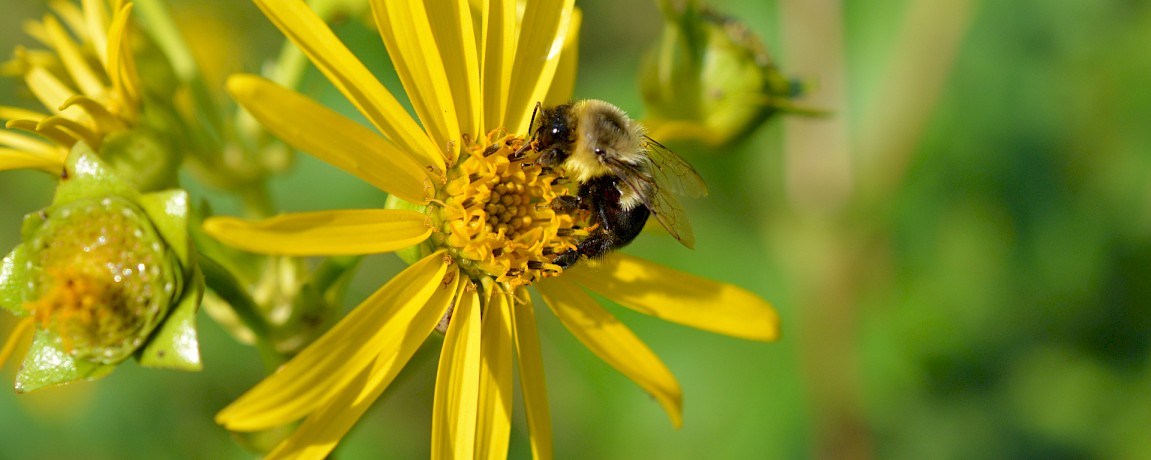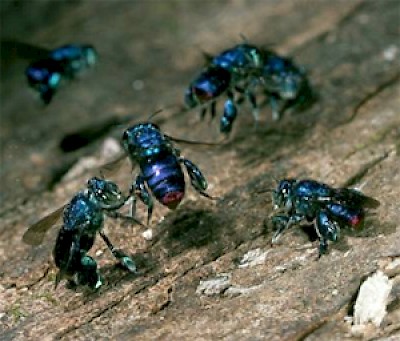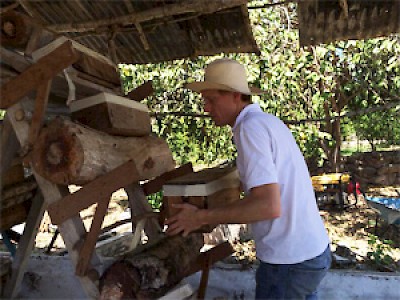Melipona Bees and the Honey of Yucatan
The Plight of the Honey Bee
Today we are all becoming increasingly aware of the plight of the honey bees. On every internet street corner, you can read about hive die-offs linked to pesticide use, genetically-modified foods, and mono-culture planting on mass scales that are diminishing bio-diversity and putting intense pressure on those tiny pollinators. The honey that many of us in the Western World usually eat comes from the European Honey Bee, apis mellifera. There is another honey bee, however, whose plight is more acute, whose honey is sublime, and who is teetering on the edge of extinction. Melipona beechi, or the stingless honey bee, is one of many species of bees that are indigenous to the Americas.
The Honey Bee of the Maya
Melipona beechii has been the honey bee of the Maya for millennia. Smaller in size than the European honey bee, the melipona beechi also cannot sting, making it a delightful species to keep at home. Traditionally, Mayan families would often have their hives tied to the sides of their homes, and indeed, in a handful of communities scattered across the Yucatan and in other parts of Mexico, primarily Puebla, you can find this practice still alive.
The Mayan bees are famous for their docile nature, but they differ in other ways as well. Their colonies are much smaller, so while the productivity of an individual bee is similar to that of the European honey bee, a hive of melipona beechi will produce only 2-3 litres of honey per year. Their stinging cousins produce a whopping 50 litres per year, a factor that has contributed to their widespread cultivation. In a world obsessed with volume, that puts the peaceful melipona beechi at a severe disadvantage. Until you taste the honey. Then you realize that Melipona honey is the closest thing on earth to the nectar of the gods.
Melipona honey is also highly bio-active, and has been used in traditional medicine for thousands of years. It is a fantastic topical antibiotic, its' use helps reduce scarring, it is used for treating cataracts, and it makes a wonderful antiseptic if you are coming down with a cold.
The Melipona bees co-evolved with the flora of semi-tropical and tropical Mexico. They are the bees that originally pollinated the tomato plant, and along with the bumblebee, are the only natural pollinators of tomatoes. Today, most commercially-grown tomatoes are pollinated by hand using vibrating wands. The Melipona bees pollinate orchids and are the main natural pollinator of the vanilla orchid. They also pollinate all the glorious wild trees that cover the Yucatan, and all plants that conventional bees just do not visit. So in addition to saving these bees for themselves, saving these bees is also of critical importance to the natural flora of the Yucatan Peninsula.
Beekeepers in Yucatan
In 2004, it was estimated by researchers at UADY, in conjunction with the Smithsonian Tropical Research Institute, that there were only 200 Melipona beekeepers left in the entire Yucatan Peninsula. Today, this number has dropped to just 120. Because these bees have co-evolved with mankind for so long, managed hives are often more successful and healthier than their wild cousins. Young people in the Maya communities these days do not have the time or the patience to take care of them, and the practice of their care is dying out.
Becoming a Beekeeper
We have started raising and caring for these bees in 2012, with the goal of training the people in our area, growing the bee population, and harvesting the honey. It is a challenging practice. The Melipona bees are vulnerable to many of the same things that plague the European bees. Because they have no stingers, these bees are also vulnerable to attacks from ants, flies, and even European bees, which try to take over their hives.
We believe that the best way to save this species is to create a market for its honey, and to take it to the world. The honey of Mexico, and of the Yucatan Peninsula in particular, is among the best honey in the world. This rare nectar is without doubt the most unique and flavorful honey that exists today. We encourage you to take the time to seek this honey out and try it for yourself. You will often find it sold in little vials at some of the many markets that pop up around Merida and in Valladolid. It is expensive, as much as $1,000 pesos for a liter (versus $10-50 pesos for a liter of conventional honey). This honey is worth it. We think it is also worth it to know that when you are buying it, you are preserving a culture, a way of life, an endangered species, and a threatened plant ecosystem. When you taste it, you will see that it is worth every penny.
Please follow us on Facebook.com/melipona. Stay informed, as there will be events and training, and both are ways to learn more about these bees and to participate in their care.
****
Travel Foundations' Melipona Bee Conservation Project
Story in WIRED magazine about beekeeping Maya women in Yucatan










Comments
Coos Baakman 6 years ago
Are these melipona the same bees as the ones that can pollinate vanilla flowers?
Reply
Lynda 6 years ago
My sons were brought up (in England) on Yucatan honey which I bought in big, white buckets.. We never used sugar - only honey as both food and medicine - it is wonderful for burns, apply it and there is no blister and no redness.
Neither of my sons, 40 and 49 now, have ever been sick and are both extremely strong, healthy men. I am 72 and hardly ever need a doctor (so far !!)
I wish I could now get this honey in New Zealand where I now live.
Reply
toni 7 years ago
I have 6 hives in Michigan i would like to visit an apairy while saying in Play Del Carmen could you assist me with an an appairy to visit I will be visiting Playa November 10-17 Thank you
Reply
Oscar Obando 9 years ago
I would like to learn to take care of the meliponia bees and have a few hives
Reply
Mary Saunders 9 years ago
There are also honey shops in Felipe Carrillo Puerto. You can also take a charming tour of the museum there, which has a mock-up of a traditional.house with hives on either side of the entrance to the home. I enjoyed this tour, and I recommend it.
Reply
Russell 9 years ago
Hi
Can Mayan bees be kept in England
Reply
DeWolf Fulton 9 years ago
My wife and I just returned from a wonderful trip to QRoo and a visit to the Mayan ruins at Coba. Much to our surprise, our 20 year old bicycle chauffeur took the time to stop along the jungle path and point out an active hive of these little creatures, about ten of them gathered around the nickel sized knot hole opening into the tree. He recounted how they produced the sweetest and most precious honey worldwide and that locals still use it for medicinal purposes. He also noted an elderly man who still practiced the difficult honey harvesting. We only regret we did not seek him out in spite of the rising and hot humidity of the day. A very intriguing addition to our Mayan venture.
Reply
Gordon 10 years ago
Great article. Thanks so much for posting.
My wife and I just spent a 10 days in the Yucatan area and visited a great little Cacao museum in Valladolid, where we learned about this great little honey bee. The museum was very interesting, not only promoting local cacao, but also the honey from these bees and other local products.
http://www.tripadvisor.com/Attraction_Review-g499453-d2357562-Reviews-Cacao-Valladolid_Yucatan_Peninsula.html
Reply
(0 to 11 comments)Next »